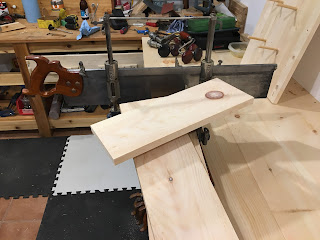First I took it apart to check that no part was broken or unusable.
 |
| The Stanley #12 in pieces. |
The sole and side were quite oxidized but were showing no damage or excessive rust so I started by cleaning the sole and ensuring it was flat.
 |
| Marked the sole with a sharpie before some scrubbing on sand paper. |
After few strokes the sole was clean and flat enough.
 |
| A clean sole. |
I applied the same to each side of the plane.
 |
| First side... |
 |
| ...second side, all clean. |
I then did further cleaning using polishing paste and compound so to remove all and any remaining iron dust.
 |
| A shiny sole... |
 |
| ... and a shiny side. |
The japanning was in good condition, almost no sign of wear, but was quite dirty so I cleaned it using the same polishing paste.
 |
| Quite dirty indeed... Looks that this plane has seen some real woodworking. |
I used the same to clean and polish the brass wheels that were not really looking like brass anymore.
 |
| Shiny brass wheel. |
The handle was in perfect shape, just dirty so I cleaned it and I had no need to refinish it. With time it got a patina that I really want to keep like it is.
 |
| All pieces back together. |
That plane did not come with a blade, or more exactly it was coming with a blade that was not really what I would call a blade, so I got this from LV:
 |
| A brand new LV blade. |
The new blade comes already ground to 45 degree...
 |
| The blade is already ground. |
... and it fit perfectly in the #12.
 |
| The new blade fit perfectly. |
I think this will be a very nice plane and I am impatient to try it, but before being able to put it back to work I need to be able to sharpened that blade properly, thing that I never did before. So this will be part of another story boys.
 |
| Some more plane porn. |





































